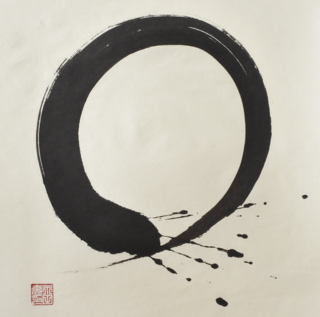Beauty
The Beauty of Imperfection
The Japanese concept of wabi-sabi.
Posted January 2, 2017 Reviewed by Ekua Hagan
Centuries back, in the height of the Japanese autumn, in one of Kyoto’s majestic gardens, a tea master asked his disciple to prepare for tea ceremony. The young man trimmed the hedges, raked the gravel, picked the dried leaves from the stones, cleared the moss path of twigs. The garden looked immaculate: not a blade of grass out of place.
The master inspected the garden quietly. Then, he reached up at a branch of a maple tree and shook it, watching the auburn leaves fall with haphazard grace on tidied earth. There it was now, the magic of imperfection. There it was, the order of nature, never far from the hands of humans. There it was, wabi-sabi, thought master Rikyu — the father of Japanese tea ceremony.
What is wabi-sabi?

Wabi-sabi has been called by many names. A “characteristic feature of Japanese beauty” (Koren, 1994); an impetus for “serene melancholy and spiritual longing” (Juniper, 2003); a nurturer of authenticity (Powell, 2004). Others have called it the “wisdom of imperfection” (Gold, 2010), as well as the “beauty of things imperfect, impermanent, and incomplete” (Koren, 1994). Or simply, the “Zen of things” (Koren, 1994).
Whatever it is — a feeling, an aesthetic, a philosophy – the connotations of wabi-sabi are layered and elaborate. They too, just like what the word signifies, were subject to inevitable transformation with the passage of time. Originally, wabi referred to “the loneliness of living alone in nature,” and sabi meant “withered” and “lean.” But the meaning of these words eventually took on more positive nuances, with wabi referring to the bittersweet melancholy of being on one’s own, while sabi connoting the grace of age or the enchantment that comes with the “bloom of times.”
For Ryotaro Matsumura, an award-winning tea ceremony master in Yokohama, wabi-sabi is an indispensable part of his daily practice. To him, it's the seemingly small things that capture the essence of wabi-sabi (“not a full moon, but a moon covered behind clouds; not new, symmetric objects, but old, asymmetric objects”). But soon, this tacit appreciation of things imperfect transcends into something with profound philosophical themes. “As human beings — however flawed and imperfect we are — when we sit together shoulder to shoulder in the backdrop of the great Nature and bond over a single cup of tea, we have the opportunity to catch a glimpse of the beauty of this short and imperfect life,” he writes.
The magic of imperfection — then and now
700 years ago, to understand imperfection was to be on the path to enlightenment. Tea masters, Buddhist monks, and others from the Japanese nobility embraced wabi-sabi through tea ceremony, calligraphy, and other cultural traditions. Thanks to Rikyu’s teachings, tea ceremony became a place and time when people could step outside their daily cares and find solace in the simple things. The single flower in a bamboo vase, the minimalist scroll, the unassuming patina — all serving as reminders of the wisdom of rustic, flawed beauty. And that nothing was ever perfect. Nor permanent.
Yet, something that appears as distinctly traditional and archaic has its place in our modern lives. Despite the Greco-Roman odes to symmetry and perfection, the notion of beauty residing in flaws has also been a part of western philosophy, literature, and aesthetics. Poets have written about life’s inevitable orders to break us all and the resulting strengths that calcify at our broken places (Ernest Hemingway). How the light comes through our cracks (Leonard Cohen). How imperfection inspires the spark of creation and imagination (Jhumpa Lahiri). Even the imperfect physical objects surrounding us can become symbols of our diligence to find meaning. Thinkers such as Kant, for instance, spoke of virtue-centric qualities of objects (or even buildings) — how their beauty can be a reflection of the human virtues of those who made them or own them. Perhaps this is why the shabby vest knitted by grandma or the scribbled love letters from our children or the broken seashell from an old friend, can turn into our dearest treasures. Because despite their imperfections, these objects become beacons of our humanity: our ability to feel, to empathize, to connect, to love.
The psychology of wabi-sabi
Wabi-sabi has a place in our psychology, as well. The relentless pursuit of perfection — in possessions, relationships, achievements – often fosters hasty judgments. This is where wabi-sabi invites a pause. It opens space. For acceptance and forgiveness. For mindfulness. For seeing the beauty of things flawed, including ourselves and our fellow human beings. For appreciating time’s passage. To acknowledge the impermanence of the world around us comes with tinges of melancholy. Most things of meaning do. Even happiness, at close inspection, has its wrinkles and rough edges. But there is also a relief. A release from the hostage of perfection. A resilience and a commitment to keep finding beauty in the most unexpected places.
Ultimately, wabi-sabi opens space for love. Love for others, and no less for ourselves. Love for our virtues and our scars, our strengths and our vulnerabilities. It is this love, according to Ryotaro Matsumura, that can lead to a deeper satisfaction with life. If we could feel it even once a day, it is this love, he notes, together with “humility and gratitude for the sun, for water, for nature, for humans — despite all our imperfections — that can infuse our days with more meaning and fulfillment.” After all, in a lifetime of fleeting moments, one after another, what bigger gift than to stare in the eyes of beauty — whatever form it may take — and to revel in its reflection of love.
Many thanks to tea ceremony master Ryotaro Matsumura from Shuhally for being generous with his time and insights, and to Japanese calligraphy artist Mitsuru Nagata (nagatayakyoto.net) for his permission to use his image of enso circle for this post.
References
Cooper, T. (2013). The Wabi Sabi Way: Antidote for a Dualistic Culture? Journal of Conscious Evolution, Vol.10.
Cooper, D. E. (2008). Beautiful people, beautiful things. The British Journal of Aesthetics, 48(3), 247-260.
De Botton, A. (2008). The architecture of happiness. Vintage.
Gold, T. (2010). Living Wabi Sabi: The True Beauty of Your Life. Andrews McMeel Publishing.
Griggs Lawrence, R. (2010). The Japanese Philosophy of Wabi-Sabi: Seeing Beauty in the Everyday. Motherearthnews. http://www.motherearthnews.com/Natural-Health/Japanese-Philosophy-Of-Wa…
Juniper, A., & Sabi, W. (2003). the Japanese art of Impermanence.
Koren, L. (1994). Wabi-sabi for artists, designers, poets & philosophers. Imperfect Publishing.
Powell, R. R. (2004). Wabi Sabi Simple: Create Beauty. Value Imperfection. Live Deeply. Adams Media.




